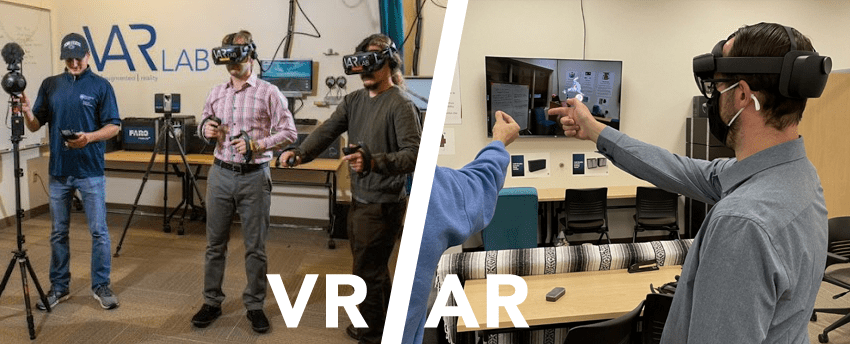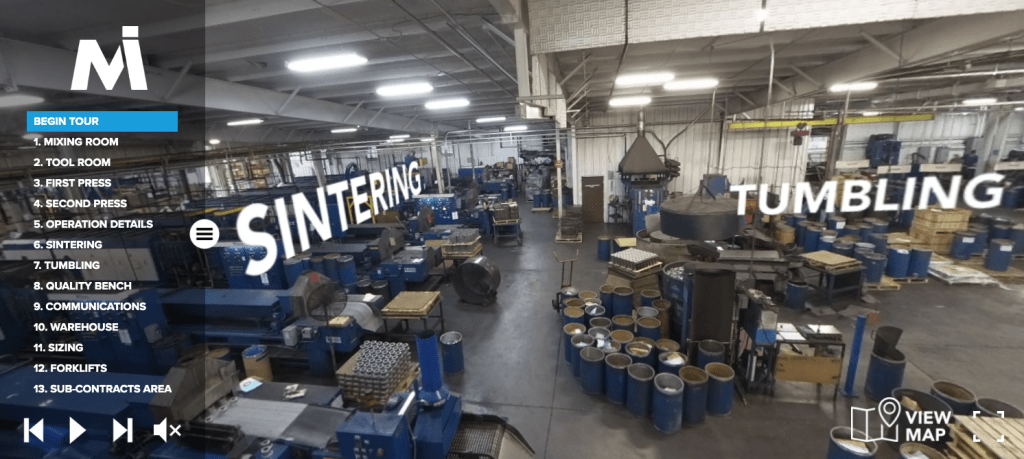
Marcus Jacobs, Chris Shelton, Jasper Sachsenmeier (left image) and Jon Gunnell (right image) in the VAR Lab at Penn State Behrend
Have you ever wanted to take your students scuba diving in the Great Barrier Reef to see the impacts of climate change or visit the Serengeti to see the Great Migration as part of a unit on ecosystems? Have you wished you could make history come to life so that students could get a glimpse of what the 1966 Apollo moon landing was like or experience a reconstruction of WWI trenches? These experiences may seem impossible to provide but through the use of immersive experiences as well as a little help from Behrend’s VAR Lab, you can incorporate these types of experiences and more into your courses.
Behrend faculty have an opportunity to incorporate enhanced learning experiences like VR and AR into their courses through the VAR Lab. The VAR Lab is equipped with headsets, computers, and other items to allow students to quickly immerse into a VR or AR environment. Faculty can help students boost their learning through the inclusion of digital immersive experiences.
To get started, let’s look at two common immersive experiences – virtual and augmented reality. Then, we will consider why VR/AR can be powerful learning experiences and share a few examples of how VR and AR can be incorporated into student learning. We will end with next steps to take to begin incorporating digital immersive experiences into your courses
What is Virtual Reality (VR)?
VR is an interactive experience wherein one can become immersed within a computer-generated environment. VR utilizes technology to create a simulated environment. To engage in the simulated environment, the user often uses a head-mounted display. The user becomes immersed in a computer-generated world when wearing this device.
What is Augmented Reality (AR)?
AR is an experience where designers enhance parts of users’ physical world with computer-generated input. Typically, AR uses technology to layer superimposed elements (i.e., images, sounds or text) on the existing world around you. Unlike virtual reality, AR builds upon your actual surroundings.
Why incorporate VR/AR into the classroom?
Students live in a technologically driven world, yet oftentimes when they enter the classroom, they are often asked to power down and power off. Incorporating digital immersive experiences into a course can help re-engage students and provide an alternative way to enhance their learning by providing novel experiences that tap into emotional and psychological connections (Renfrew, 2021, Fierce Education). Higher education should be seen as a leader in preparing students for a technologically advanced world and should seek to provide educational opportunities that are “more stimulating, as well as transformative intellectually and developmentally purposeful” (Mintz, 2021, Inside Higher Ed). One way to offer these types of educational opportunities is through VR/AR.
There are many benefits of VR, according to Adobe:
- Better sense of place: Students can learn about a subject by living it.
- Learning experiences at scale: Educators can create virtual labs to cut costs and increase accessibility.
- Learning by doing: Students can learn by performing tasks instead of simply reading.
- Emotional reaction: Educators make memorable experiences for students to increase their retention.
- Creative development: Technology often increases opportunity for students to be creative.
- Visual learning: Educators can increase learners’ comprehension of educational content by providing visual components.
How can VR/AR be incorporated into the classroom?
These two technologies have great potential for use in the classroom. With access to the equipment in the VAR Lab, instructors can incorporate immersive experiences and projects related to VR and AR into their classes. VR/AR are most impactful when they are purposefully embedded in the content. Instructors should consider the learning objectives for the course and lesson and determine what pre-learning activities and post-reflection activities they can wrap around a VR/AR experience to ensure it is embedded as a true learning experience. Learning goals that can be achieved through digital immersive experiences include applying theoretical concepts in real-world scenarios and immersing students in places through virtual field trips.
Use AR/VR to apply theoretical concepts in real world scenarios.
VR/AR can allow students to take their learning to the next level by applying theoretical concepts in real world scenarios. Students often struggle to transfer their learning from the classroom to novel situations or contexts. VR/AR can provide the students with the opportunity to practice concepts in technologically enhanced or built environments.
In Math 230: Multivariable Calculus, students were able to use digital 3D models that they viewed through smart devices using a MERGE Cube to better understand Derivatives and Integrals of Vector Functions. The augmented reality of the models allowed students to see the three axes that are otherwise difficult to understand in 2D or on paper alone. GeoGebra 3D Calculator can also be used for students to visualize complex mathematical structures as an overlay in their own environment through their smartphone. These AR tools can allow students to move beyond basic memorization of equations toward visualizing the models to apply to real world situations.
Forensic Detective is an AR experience that allows students to follow a story in order to try to solve a murder and figure out who a murderer is. This type of AR driven activity can be embedded in a creative writing course by asking students to write spinoffs of the story or to take the perspective of another character in the story. It can be used in a criminal justice course to discuss the skills used to review clues and the decision making process in trying to solve the crime. The options for enhancing learning through AR are limitless. With intentional instructional decisions built around the AR experience, student learning can be enhanced.
Use VR to take virtual field trips.
Virtual field trips can have a plethora of benefits in the classroom. They are more cost effective for students who may not be able to afford the expense of traveling. Virtual field trips are also able to reach a variety of students who may otherwise not be able to attend due to time constraints, a disability, or other logistical concerns. Lastly, virtual field trips can enhance student engagement and allow for depth of learning.
Instructors can use a virtual field trip to start a new module in order to grab students’ attention or enhance a topic by providing additional context. There should be assignments built around the virtual field trip, which might include a complementary reading assignment or a discussion or written reflection after the virtual field trip.
Google has a library of experiences to far off and wondrous places called “Expeditions.” These experiences use a mix of 360 degree and 2D imagery as well as text to immerse students in the environment. Topics in their library include places like the Amazon, the Palace of Versailles, and Machu Picchu. Other Expeditions are on topics like animal camouflage, archeological dating, how computers work, and so much more. Check out the list at the Arts and Culture Expeditions website.
The Center for Teaching and eLearning Initiatives (CTEI) created a 360-degree virtual tour of Metco Industries in St. Marys as a virtual field trip for online students. This tour has been embedded into QMM 593: Field Experiences in Manufacturing so that students can see the various parts of a working facility. Students interact with the 360-degree tour and then submit a Lean Manufacturing Audit, which asks students to evaluate the facility’s safety, as an assignment.

Through the immersive experience of VR that touches on more of the senses, these virtual reality experiences can enhance student learning by providing a rich experience that reading a description about a place or watching a video on a topic cannot match.
Teaching for the Future
Corporations like IKEA, Hyundai, Walmart, Boeing and more are increasingly using immersive technologies in their daily operations. Using digital immersive experiences to enhance learning is a best practice for instructors seeking to teach for the future by preparing students for careers in technology rich environments. There are a few steps you can take to begin to incorporate VR and AR into your classes.
- Identify a learning goal that would be enhanced by either VR and/or AR.
- Share your idea with the VAR Lab or CTEI to begin discussing creating the learning.
- Add the VR and/or AR content and assignments to your course.
- Work with the VAR Lab during the semester to implement the VR/AR related assignment.
If you’d like to learn more about how to begin to integrate VR and AR into your classroom or schedule a visit to the lab, contact Chris Shelton, Director, and the VAR Lab staff at Varlab@psu.edu.
Sources:
Adobe, “How VR in Education Will Change How We Learn and Teach”
AR Post, “4 Inventive Examples of Virtual Reality in Education”
Built In, “Virtual Reality in Education: An Overview”
CNN, “Can Virtual Reality Revolutionize Education?”
Fierce Education, “The Connected Campus: Building the Next Generation Network
Forbes, “The 5 Biggest Virtual and Augmented Reality Trends in 2020 Everyone Should Know About”
Inside Higher Ed, “What do we mean by Educational Innovation?”

